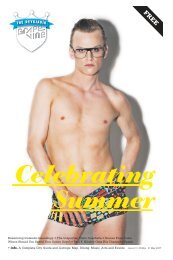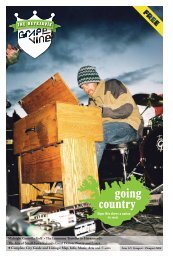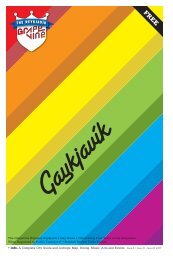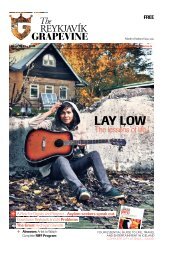7 august - The Reykjavik Grapevine
7 august - The Reykjavik Grapevine
7 august - The Reykjavik Grapevine
You also want an ePaper? Increase the reach of your titles
YUMPU automatically turns print PDFs into web optimized ePapers that Google loves.
lengths of piping for water and<br />
heating than high-density multifamily<br />
areas. <strong>The</strong>y are, in other<br />
words, less efficient and more costly<br />
to maintain.<br />
At the same time, the Planning<br />
Council doesn’t exactly warmly<br />
embrace the idea of developing the<br />
islands and having an inordinate<br />
proportion of single-family homes in<br />
Reykjavík.<br />
Bragadóttir cut to the heart of<br />
the argument, taking the pragmatic<br />
approach: “Before we build on land<br />
fillings and the islands,” she told the<br />
<strong>Grapevine</strong>, “we should first build<br />
on the land we already have on the<br />
peninsula. We should wait a while<br />
before using land fillings. It’s just<br />
common sense. It’s true that people<br />
did live on Víðey, but that changed,<br />
and we should now first consider<br />
where it’s already more practical to<br />
build, on the peninsula.”<br />
Others, such as Stefánsson, don’t<br />
even consider the plan realistic. As<br />
he told the <strong>Grapevine</strong>, “I find the<br />
idea of developing the islands around<br />
Reykjavík to be a kind of utopia<br />
that’s fun to think about, but I don’t<br />
think it would be a reality.”<br />
In order to maintain high<br />
density and a high quality of life,<br />
the Planning Council has proposed<br />
a development “mix” of apartments<br />
and single-family homes. That<br />
proposal, called the “Five Flowers,”<br />
focuses on five areas of the city:<br />
the Mýrargata-Slippasvæði of the<br />
west harbour area, the east harbour<br />
area, the neighbourhood around the<br />
bus terminal Hlemmur, the largely<br />
industrial area of Elliðaárvogur, and<br />
the crucial Vatnsmýri, where the<br />
city airport currently resides. All of<br />
these areas will be predominantly<br />
apartments, thereby keeping density<br />
high, but Bragadóttir doesn’t believe<br />
that necessarily means building<br />
upwards.<br />
“I don’t think building up is the<br />
only answer,” she told the <strong>Grapevine</strong>.<br />
“We can build denser by building<br />
lower, maybe five to seven stories<br />
high. An important thing to be<br />
aware of is urban spaces on a human<br />
scale and an easy access to daily<br />
needs and the nature around us. It’s a<br />
question of quality of life.”<br />
When asked how taller buildings<br />
would affect the quality of life of<br />
the city’s residents, Bragadóttir<br />
cited aesthetics, saying, “You get the<br />
view, but the building can be out of<br />
touch with the space. Regarding the<br />
importance of quality of the urban<br />
space, you have to have in mind,<br />
for example, at this altitude tall<br />
buildings cast very long shadows and<br />
can in fact generate a windy microclimate.”<br />
Eggertsson is particularly<br />
passionate about what he’d like to<br />
see happen in the Five Flowers.<br />
In addition to building<br />
apartments in the west harbour area,<br />
he told the <strong>Grapevine</strong> that he’d<br />
also like to “build up the harbour<br />
atmosphere with fish markets,<br />
squares, and ports for small boats.<br />
<strong>The</strong> Maritime Museum just opened<br />
there, which is a good start, but we<br />
want to see more, with a link to the<br />
city centre.” In the east harbour, the<br />
Planning Council has designs on<br />
building a concert hall, hotels, retail<br />
outlets, restaurants and even a new<br />
headquarters for Landsbanki.<br />
Hlemmur seems to be what<br />
Eggertsson would like to be the new<br />
hub of Reykjavík youth culture.<br />
“We’d like to see at least a<br />
thousand new apartments in that<br />
area,” he told the <strong>Grapevine</strong>, “maybe<br />
with a focus on young people and<br />
students, who use the bus more than<br />
Plans for high rises on Reykjavík’s<br />
Skuggahverfi by the City Planning Council<br />
other demographics, and to build<br />
fewer car parks. Right now the area<br />
is too much like a slum. What we<br />
want is a dynamic mix of youth,<br />
culture and city functions.”<br />
<strong>The</strong> largely industrial area<br />
of Elliðaárvogur is trickier, as the<br />
question arises, how do you convince<br />
people to move into an industrial<br />
area? On this point, Eggertsson says,<br />
“[<strong>The</strong> area] could be one of the most<br />
beautiful places to live and work.<br />
We’ve proposed moving the heaviest<br />
industries to the outskirts of town or<br />
having them refreshed. Instead, we<br />
want to see a dense residential area<br />
by the sea.”<br />
But the real crown jewel of the<br />
bunch is Vatnsmýri. If the city<br />
airport is moved to Skerafjörður as<br />
many have proposed, this will free up<br />
an enormous swath of land within<br />
city limits. Bragadóttir herself sees<br />
the area as having the potential to<br />
contain “thousands of flats,” while<br />
Eggertsson adds that he’d like to<br />
see the area be the new science and<br />
technology district of Reykjavík.<br />
“<strong>The</strong> area could be home of the<br />
knowledge industry in its closeness<br />
to the University of Iceland, the<br />
hospital and the University of<br />
Reykjavík,” he told the <strong>Grapevine</strong>.<br />
“We want knowledge-based<br />
industries to find a home there.”<br />
When told of the Five Flowers<br />
proposal, Firchow was very positive.<br />
“That sounds like the right<br />
approach,” he told the <strong>Grapevine</strong>.<br />
“In the 1950s in America, you had<br />
these ‘bubbles,’ where there were<br />
single-family homes in one bubble,<br />
apartments in another, and services<br />
in yet another. This segregation of<br />
services puts a lot of pressure on<br />
a city’s infrastructure. Integration<br />
of use [like the Five Flowers plan]<br />
is a much more appropriate use of<br />
space.”<br />
<strong>The</strong>se housing ideas and<br />
others are still up for debate,<br />
and will undoubtedly be debated<br />
fiercely in the planning meetings to<br />
come. More often than not, these<br />
discussions become politicized. One<br />
undercurrent as to why city planning<br />
in Reykjavík is often very politicized<br />
is illustrated in University of Iceland<br />
Professor of Urban Planning<br />
Trausti Valsson’s book Planning<br />
in Iceland from the Settlement to<br />
Present Times. Valsson contends<br />
that politics often get in the way of<br />
effective development.<br />
Created in 1972, the<br />
Development Office has seen<br />
different ruling parties come<br />
and go - the Leftists who came<br />
to power in the late 70s rejected<br />
many of the conservatives’ earlier<br />
planning proposals, and when the<br />
conservatives regained power in<br />
1982, they, in turn, rejected many<br />
of the development proposals<br />
the Leftists had begun, such as<br />
further development of Reykjavík’s<br />
far eastern, mainland section.<br />
Politicizing development naturally<br />
slows down the process.<br />
Knowing that any plan set forth<br />
during your watch will immediately<br />
be cancelled if another political<br />
party is elected makes for rash<br />
decisions. Many cite as an example<br />
the current Miklabraut-Hringbraut<br />
construction project that connects<br />
these two four-lane roads with a<br />
six-lane road that bows over 50<br />
metres away from the hospital. Apart<br />
from the fact that placing a six-lane<br />
road as a connection between two<br />
four-lane roads is an invitation to<br />
severe bottlenecking of traffic in<br />
either direction, there were also<br />
25<br />
complaints that the plan was pushed<br />
through and approved quickly, with<br />
little chance for discussion among<br />
planners or the public. <strong>The</strong> plan’s<br />
lack of popularity - yet its ultimate<br />
passage - can be taken as a warning<br />
of things to come: Vilhjálmsson’s<br />
expressway and island communities<br />
might not be very popular ideas, but<br />
that doesn’t necessarily mean they<br />
won’t be approved.<br />
On the other hand, as of now,<br />
the Independence Party does not<br />
control City Council. <strong>The</strong>y hold six<br />
of the council’s fifteen seats, with<br />
opposition alliance R-list controlling<br />
eight seats (the fifteenth seat is held<br />
by the sole Liberal Party member<br />
on the council, Ólafur Friðrík<br />
Magnússon). In addition, Mayor<br />
Steinunn Valdís Óskarsdóttir hails<br />
from the Alliance Party. R-list holds<br />
the majority - albeit a slim one<br />
- so the planning ideas put forth<br />
by the Independence Party could<br />
be defeated by the opposition. Or,<br />
if the next elections go the other<br />
way, Independence Party proposals<br />
could roll through with relative ease<br />
– latest Gallup Poll results indicate<br />
that 47% would vote R-list and 48%<br />
would vote Independence Party if<br />
City Council elections were held<br />
today. Whether it goes one way or<br />
another has a lot to do with public<br />
involvement from the very start<br />
– planning meetings are regularly<br />
advertised and are open to the public.<br />
With City Council elections coming<br />
up next spring, Reykjavík’s residents<br />
can also choose through their votes<br />
what they want their city to be: an<br />
unsustainable suburb that ultimately<br />
serves no one, or a thriving city that<br />
maintains a high quality of life for<br />
all and could even set an example for<br />
capital cities the world over.










